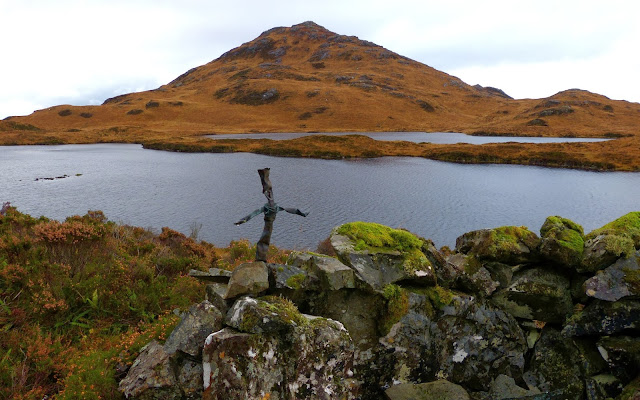With the forecast promising us a 'strong breeze' and heavy rain by early afternoon, we set out in good time this morning for a brisk walk around the eastern end of the ridge behind our house,
Druim na Gearr Leacainn. We hadn't been walking for more than a quarter of an hour before it began to rain, with the clouds coming low across Ben Hiant.
The view in this picture looks across Kilchoan Bay, with the village strung out around it, towards the mouth of Loch Sunart and the hills of Morvern.
The hill at the northeast end of the ridge is called
Tom na Moine. As we rounded it and began to climb towards the twin lochans, it stopped raining and a patch of brilliant sunshine drifted across Estate land.
On the saddle at the east end of the bowl of land which the twin lochans occupy is this lonely steel post. It stands on the boundary between the common grazings of the crofting townships of Ormsaigbeg and Ormsaigmore. Its vertical is set into the bedrock: it would be interesting to know how the hole was drilled.
As the steep cliff which forms the north face of
Druim na Gearr Leacainn came into view three red deer hinds broke cover and ran away from us, disturbing a small flock of sheep. This is the closest we've seen deer to the Ormsaigbeg croft lands: much closer, and they'll be visiting our vegetable gardens at night.
Below the cliff is this semi-circular cairn which commemorates the place where, in February 1944, Flight Lieutenant Arthur Woodgate's hurricane fighter flew into the hill, killing him. It's a dark, lonely spot, looking out across the lochans to
Ben na Seilg.
A little further on there's a point where the cliff falls back and it's possible to scramble up to the ridge line. By this time the wind had risen, bouncing over the hill and coming down vertically onto the lochans, forming catspaws which chased each other across the water.
As we came onto the south side of the ridge and looked across the Sound of Mull, searchlights of sunlight were moving across the sea. Only one ship moved, the Tobermory-Kilchoan ferry, the
Raasay, a speck in the immensity of sea and sky.
A map of the area is here.























































